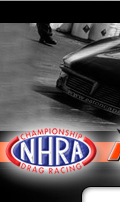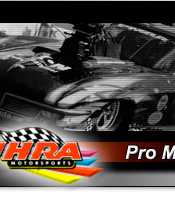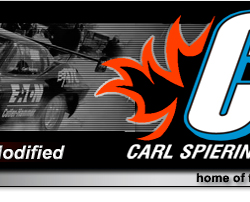Carl
Spiering
 With a serious passion for fast machines in any type of competition, Carl Spiering from Jordan Station, Ontario, and his Carl Spiering Motorsports Eaton 1967 Chevrolet Camaro Supercharged Pro Modified is quickly becoming one of the hottest Pro Modified racers on the drag race circuit. With a serious passion for fast machines in any type of competition, Carl Spiering from Jordan Station, Ontario, and his Carl Spiering Motorsports Eaton 1967 Chevrolet Camaro Supercharged Pro Modified is quickly becoming one of the hottest Pro Modified racers on the drag race circuit.
Although he did not win the championship,
Carl Spiering believes his 2006 campaign in the competitive
IHRA Torco’s CompetitionPlus.com Pro Modified division
was successful. Consistency in qualifying, plus a stout and
dependable engine program were key factors to his performance
again this year.
“Consistency was key to our success
this year and the G-Force Race Cars Eaton Road Warrior,”
said Spiering. “We were one of only two teams (the other
being Quain Stott – 2006 IHRA World Champion) that qualified
for every one of the 11 IHRA national events this season.
For 2006, we averaged sixth spot in qualifying for all the
events, with an average low ET of 6.14 seconds, making us
the highest average qualifier over all of our competitors.”
This highest average qualifier status gave
Spiering and his team the best “batting average”
for the season. While other teams may have qualified higher
or lower at certain events, the Eaton Road Warrior always
qualified well at each event with a steadiness and reliability
that no other Pro Modified team matched.
Most IHRA National events featured fields
of over 30 Pro Modifieds, with a couple of events topping
40 cars and two boasting the quickest qualified fields in
IHRA history, all vying for the top 16 spots for elimination
rounds.
Spiering, the 42-year old driver from Jordan Station, Ontario, finished the season in seventh position in the IHRA 2006 eMax Nitro Jam™ Drag Racing Series in his Eaton 1967 Camaro and continues to be a contender in the chase for the 2007 Torco Race Fuels Pro Modified Shootout.
Spiering added he was particularly pleased
with his engine program, which has remained rock-solid over
the past several seasons.
 "We
have gone three consecutive years with no powerplant failures
with our ERD engine program,” he said. “Our ERD
(Engine Research and Development) facility features a new
state of the art Dynamic Test Systems (DTS) dynamometer system
that allows our engines to be tested, developed and race ready
when we get to the track. Although our race luck was not there
this year we want to emphasize our success at being one of
the very few teams to qualify at each event.” "We
have gone three consecutive years with no powerplant failures
with our ERD engine program,” he said. “Our ERD
(Engine Research and Development) facility features a new
state of the art Dynamic Test Systems (DTS) dynamometer system
that allows our engines to be tested, developed and race ready
when we get to the track. Although our race luck was not there
this year we want to emphasize our success at being one of
the very few teams to qualify at each event.”
The Torco Race Fuels Pro Modified class features
a special program based on each team’s final qualifying
spot at each national event. The top eight in points will
have the opportunity to participate in the 2007 Torco Race
Fuels Pro Modified Shootout, which will be held at the IHRA
Northern Nationals in Martin, Michigan. Spiering remains in
the number one position in this category and has kept this
since winning the 2005 Shootout again reinforcing his consistently
strong performance throughout the 2006 season.
In 2005, Spiering had a strong season as
he stepped up his race program, winning the IHRA Torco Race
Fuels Pro Modified Shootout and the IHRA ACDelco Nationals
and placed third in the IHRA World Championship National Event
Tour.
"That is a great accomplishment especially
when you consider we only ran nine of the 12 national events
during the 2005 season," explained Spiering. "Our
new engine program with the Brad Anderson Hemi power and a
great car from Tim McAmis helped us run our best time ever,
6.07-seconds at 235 miles per hour."
Starting with a Pro Street 1980 Chevrolet
Malibu that he street raced around the Niagara Falls on Sunday
nights, Spiering found he was destined to compete at the drag
strip.
At the track, his Malibu was capable of 11.90-second
elapsed times using a small-block Chevrolet engine. He dreamed
of some day building a "9.90" car and running Pro
ET, but as a young married man he simply did not have the
resources to build one to the level he desired.
Undaunted, he instead began racing snowmobiles
on grass courses, where his professional racing career started.
The success he enjoyed with his 650-cc Polaris did not go
unnoticed and Bombardier, manufacturers of Ski-Doo snowmobiles,
who offered him a factory-sponsored ride with full support.
He operated his snowmobile racing team for
four years, topping his sled racing with a class win at the
New York State Grass Drags.
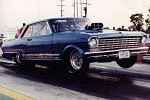 On
his way back to the quarter-mile, Carl purchased a 1964 Chevy
II in Tennessee powered by a 468 cubic inch big block Chevy
engine hooked to a two-speed Powerglide transmission. With
recent changes to chassis regulations, Carl's Chevy II was
not certifiable so he enlisted Eddie Bryck of the Chassis
Shop in Toronto to build him a new chassis for the Deuce.
At the same time, Carl decided the car needed some more go-power,
as he wanted to run in the "fast" bracket. On
his way back to the quarter-mile, Carl purchased a 1964 Chevy
II in Tennessee powered by a 468 cubic inch big block Chevy
engine hooked to a two-speed Powerglide transmission. With
recent changes to chassis regulations, Carl's Chevy II was
not certifiable so he enlisted Eddie Bryck of the Chassis
Shop in Toronto to build him a new chassis for the Deuce.
At the same time, Carl decided the car needed some more go-power,
as he wanted to run in the "fast" bracket.
He began building an all-aluminum 588-cubic
inch big block pure racing engine with alcohol injection.
The new combination worked well and the car's performance
level jumped into the 8.50-second range at speeds of 165 miles
per hour. For the next two seasons, Carl campaigned the car
in that trim and although he was usually in the hunt, he did
not record any particularly notable wins.
 Noticing
the growth and interest the Top Sportsman class was attracting
at this time, Carl decided to advance his career and build
a T/S car. Joe Van Overbeek of London, Ontario was selected
as the chassis builder and a new Camaro was chosen as the
body style. After taking all of 1994 and the first half of
1995 to complete the car, it debuted in mid-1995. A supercharged
540 cubic inch big block, Carl's first "blown" engine,
and a Bruno/Lenco transmission made up the powertrain. Noticing
the growth and interest the Top Sportsman class was attracting
at this time, Carl decided to advance his career and build
a T/S car. Joe Van Overbeek of London, Ontario was selected
as the chassis builder and a new Camaro was chosen as the
body style. After taking all of 1994 and the first half of
1995 to complete the car, it debuted in mid-1995. A supercharged
540 cubic inch big block, Carl's first "blown" engine,
and a Bruno/Lenco transmission made up the powertrain.
Carl traveled to Bristol, TN for the IHRA
Fall Nationals, and in his first national event, he qualified
with an impressive 7.31-second elapsed time. Rain delayed
the event until the next weekend, but Spiering chose to stay
over and was rewarded with a third-round finish.
The Camaro was campaigned throughout 1996
season before selling it to Hamilton-racer Bruce Boland. Spiering
wanted to race Pro Modified, but he knew he would need the
financial resources if he were to make this dream a reality.
So to help get the money needed to race in this popular class,
he started the business that he runs to this day, The Trailer
Shop. He also accepted an offer from fellow Canadian racer
Barry Paton to spend a year working on Barry's team to learn
clutch maintenance.
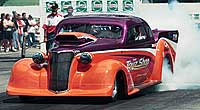 In
1998, Carl debuted a beautiful 1937 Chevrolet, which he had
purchased at the end of the previous season. Powered by a
632 cubic inch Dart Big Chief engine on nitrous and backed
by the Bruno transmission from his old Camaro he ran the full
season at Grand Bend Motorplex where he won four events and
was ultimately crowned the 1998 Grand Bend season Top Sportsman
Champion. In
1998, Carl debuted a beautiful 1937 Chevrolet, which he had
purchased at the end of the previous season. Powered by a
632 cubic inch Dart Big Chief engine on nitrous and backed
by the Bruno transmission from his old Camaro he ran the full
season at Grand Bend Motorplex where he won four events and
was ultimately crowned the 1998 Grand Bend season Top Sportsman
Champion.
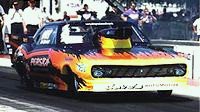 Carl
joined forces with the Persico Bros. in 1999 and drove their
nitrous-assisted 1967 Pro Modified powered by a 706 cubic
inch Eagle. That year was a great learning curve for Spiering,
and an ultimate team decision was made to switch the power
plant from a nitrous-oxide injected engine to a supercharged
mount. Carl
joined forces with the Persico Bros. in 1999 and drove their
nitrous-assisted 1967 Pro Modified powered by a 706 cubic
inch Eagle. That year was a great learning curve for Spiering,
and an ultimate team decision was made to switch the power
plant from a nitrous-oxide injected engine to a supercharged
mount.
 In
2000, the team changed to blown 526 cubic inch Chevrolet engine
and was armed with new sponsors. Extreme Championship Wrestling
and Pace American Trailer were the major contributors. Carl
and the team had a great year, winning several rounds of eliminations,
two-quarter final finishes, a number-two qualifying position
at his home track in Grand Bend, best appearing professional
team, and the third most published photos of any IHRA car
that year. In
2000, the team changed to blown 526 cubic inch Chevrolet engine
and was armed with new sponsors. Extreme Championship Wrestling
and Pace American Trailer were the major contributors. Carl
and the team had a great year, winning several rounds of eliminations,
two-quarter final finishes, a number-two qualifying position
at his home track in Grand Bend, best appearing professional
team, and the third most published photos of any IHRA car
that year.
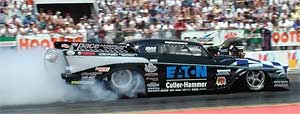 While
assessing his future in 2000, Carl decided to order his own
Pro Modified, a 1957 Chevrolet Bel Air. 2001 was a busy year
for Carl as he secured primary sponsorship for the season
with Eaton's electrical group in Canada and assistance from
Pace American Trailers. Carl's Bel Air got off to a flying
start, winning an IHRA National Event at Maryland International
Raceway in Budds Creek, MD to give Carl his first national
event win. While
assessing his future in 2000, Carl decided to order his own
Pro Modified, a 1957 Chevrolet Bel Air. 2001 was a busy year
for Carl as he secured primary sponsorship for the season
with Eaton's electrical group in Canada and assistance from
Pace American Trailers. Carl's Bel Air got off to a flying
start, winning an IHRA National Event at Maryland International
Raceway in Budds Creek, MD to give Carl his first national
event win.
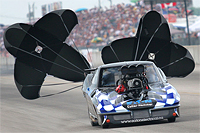 After
a strong season but no wins in 2003, Carl jumped at the chance
to purchase Tim McAmis' personal 1963 Corvette Pro Modified
at the end of that season. Carl struggled early in 2004 but
after a successful session on the dyno, the second half of
the year went much better with a much stronger engine. This
past winter Carl put the last piece of the puzzle together
when he purchased his own state-of-the-art Dynamic Test Systems
(DTS) dynamometer system for his business Engine Research
and Development, providing customers with the latest in power
plant technology and created his own engine department. After
a strong season but no wins in 2003, Carl jumped at the chance
to purchase Tim McAmis' personal 1963 Corvette Pro Modified
at the end of that season. Carl struggled early in 2004 but
after a successful session on the dyno, the second half of
the year went much better with a much stronger engine. This
past winter Carl put the last piece of the puzzle together
when he purchased his own state-of-the-art Dynamic Test Systems
(DTS) dynamometer system for his business Engine Research
and Development, providing customers with the latest in power
plant technology and created his own engine department.
Carl appreciates the great relationship and
strong support that he receives from his major sponsor, Eaton.
He also has the strong support of his wife and daughters.
In fact, both of his daughters race Junior Dragsters very
successfully as another generation of racing Spiering is being
developed. |
